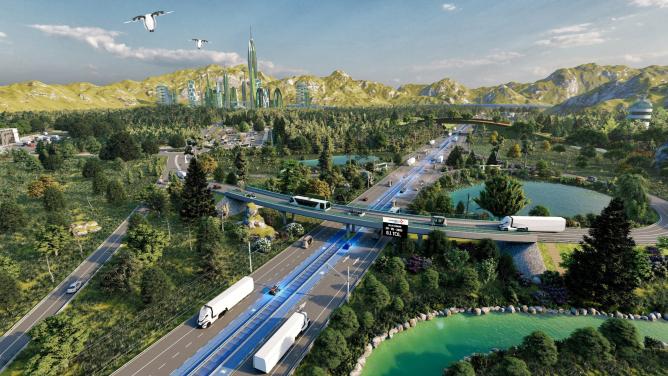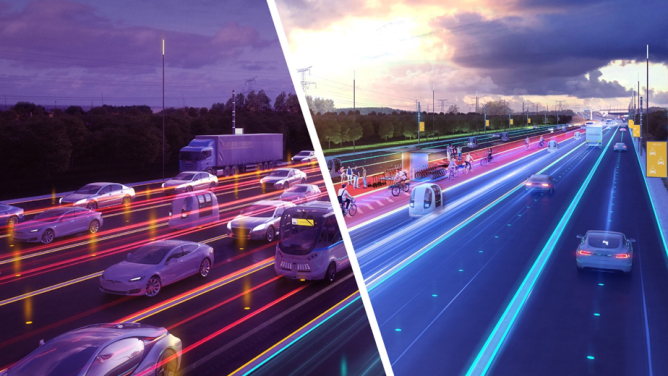What are the main steps to achieving zero-carbon roads in Europe?
Let’s start by looking ahead to 2050, the furthest date for the ultimate goal of carbon neutral transport. Of course, intermediate steps are necessary to get there, as the step is quite high. By 2030, Europe will require many industrial sectors, including transport, to reduce CO2 emissions by 55% compared with their current levels. Last July, a draft European regulation specified the steps to be taken to get there, while introducing new constraints. These included the requirement, by 2030, for light vehicle manufacturers to ensure that their vehicles emit 55% less CO2 on average than vehicles sold in 2021. Followed, in 2035, by a complete ban on the sale of new petrol and diesel vehicles. It is a very important measure, bringing forward the timetable for some countries, including France, which had previously set a deadline of 2040. This is accompanied by other requirements relating not to vehicle sales, but to traffic. In France, low-emission zones – which restrict the most polluting vehicles’ access to city centres – are now in place in a dozen urban areas. In 2025, the climate and resilience law adopted in July 2021 in France will extend those limits to 34 urban areas – in practice, all cities with more than 150,000 inhabitants. There are already 247 Low Emission Zones (LEZs) in 13 European countries. The legislative and regulatory environment will force us to switch to zero-carbon transport.
In Europe, we know that the proportion of electric vehicles almost doubled between 2020 and 2021 but that, even now, they still represent less than 2% of all European cars. What role will electric vehicles play in the low-carbon transition?
In the light vehicles category, the technology needed to achieve zero-carbon transport is well known and beyond debate, i.e. battery powered electric vehicles. Having said that, a few figures need to be borne in mind. In France, for example, there are a total of 33 million light vehicles on the roads. Grants to purchasers have ensured that electric vehicles account for 10% of all new vehicles sold. But if we look at the number of electric vehicles on the road, the total stands at just under 400,000 vehicles… out of 33 million. So there is a real challenge in terms of renewing the fleet. Yet the additional cost of replacing a petrol or diesel vehicle with an electric vehicle remains at around €10,000 to €15,000. Grants are helping to reduce this additional cost and restrictive measures such as LEZs should accelerate the movement. If we take heavy goods vehicles, for example, the electric battery not only imposes limits in terms of driving range, but also operational drawbacks in terms of the time the vehicle needs to be stationary while charging, as well as the volume and weight of the battery, which affect the payload. Despite these limitations, batteries remain the preferred solution for some manufacturers. Others choose hydrogen. Hydrogen does not have such severe payload constraints. Neither does it require recharging time, as it is very quick to fill up. The real limitation is the availability of zero-carbon hydrogen. The sector is certainly growing and significant investments are being made, including €9 billion in government funding in France. But hydrogen is needed to reduce carbon consumption in numerous sectors and heavy industry will account for the majority of supplies in the short term. The mass availability of zero-carbon hydrogen for transport before 2030, therefore remains a moot point.
Is road infrastructure ready for zero-carbon transport?
The roll-out of electric vehicle charging points in service areas is an essential prerequisite for the development of electric transport. That is why VINCI Autoroutes is rolling out fast (50kW) and ultra-fast (150kW) charging points at its service areas. So far nearly two-thirds are equipped and the aim is to extend this to all service areas by 2023. This is a very ambitious target. This initial campaign is vital to encourage electric vehicle take-up by overcoming range anxiety, but will quickly become insufficient as the growth in electric vehicles outstrips that of infrastructure. In a July 2021 report, for example, RTE and ENEDIS estimated that within the next ten years, in order to meet peak demand at the start of the main holiday seasons, an average capacity of 4 to 12MW will be needed per service area. This represents between 20 and 60 200kW charging points in each area, with the largest having up to 200 charging points supplying 40MW. This is the equivalent of the power supplied to Orly airport (Paris)! The investments needed are therefore colossal and must be planned for now.
What contribution can be made by “dynamic” charging, i.e. via induction, catenaries or rails?
This is attracting significant research and development resources and is the subject of a roadmap, in France, led by the Transport Ministry and the DGITM (General Directorate of Infrastructures, Transport and the Sea), supported by around 60 experts and to which we have contributed. In the motorway sector, infrastructure managers such as VINCI Autoroutes are in favour of induction on operational, maintenance and repair grounds, since solutions involving catenaries or rails are more difficult to maintain. Induction technologies – transmitter loops embedded in the road surface – are easier to operate and repair. French work on dynamic charging indicates the need for a massive roll-out of electric road systems from 2030. A report published by the DGITM this summer recommends installing dynamic charging on 5,000km of roads by 2030 and 9,000km by 2035. That is the equivalent of the entire national motorway network. This massive roll-out will prioritise heavy goods vehicles, with other vehicle categories gradually catered to via dedicated lanes. This will involve launching major worksites in parallel, although there are no major obstacles from a technical perspective. As for the power supply, one of the advantages of dynamic charging is that it distributes the power demand over a longer line, thereby reducing the sizing of localised power points. Most importantly, we need to assess the advantages of these electric motorway systems in terms of their carbon reduction. This could reduce the CO₂ emissions generated by long-distance road transport by 87% compared with the current diesel vehicle fleet. This will require everyone to move forward at the same pace, including construction companies, infrastructure operators, management companies and the public authorities.
This interview is from Leonard’s Yearbook “A Decisive Decade” 2021-2022. Discover it by following this link.


